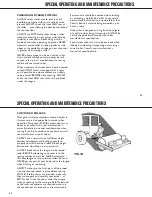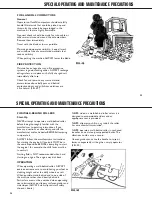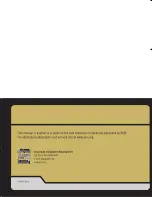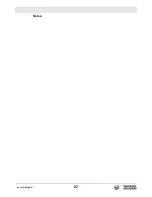
25
Loading and unloading machines always involves
potential hazards. EXTREME CAUTION SHOULD
BE USED.
Know the correct loading and unloading procedures
for your machine.
All machines are not loaded and unloaded the
same way.The procedures recommended by the
manufacturer should always be followed.
Several precautions are applicable to all machines:
•
NEVER load or unload machine by yourself.
•
Keep all non-essential personnel clear of loading
and unloading area.
•
Load and unload on a level surface.
•
ALWAYS use ramps of adequate size and strength.
Be sure ramps are sufficiently wide, and long
enough to provide a safe loading slope.
•
NEVER use ramps that are cracked, damaged, or
of questionable strength. (FIG. 27)
•
Be sure that the ramps are securely positioned
and fastened, and that the two sides are at the
same level as one another.
•
The ramp surface must provide adequate traction.
Be sure the surface is clean and free of grease,
oil, ice, and loose material.
•
The hauling vehicle should be blocked to prevent
movement during loading or unloading of the
machine.
•
For proper tie-down instructions, see the
manufacturer’s manual.
LOAD AND UNLOAD MACHINE SAFELY
KE40246P2 6/9/05 3:17 PM Page 25
26
GENERAL
When towing a machine on a trailer, or a machine
equipped with “portability or transport wheels”,
ALWAYS use a hauling vehicle of sufficient weight,
horsepower and braking capacity to maintain
proper control.
NEVER attempt to tow a trailer or machine if the
hitching devices are of insufficient or questionable
capacity, improperly matched in size or shape, or
positioned at improper heights.
When towing a machine equipped with portability
or transport wheels, ALWAYS follow the
manufacturer’s towing instructions.
BEFORE TOWING
When connecting a trailer to a hauling vehicle,
block under the trailer’s tongue before attempting
to make the connection. NEVER attempt to lift
heavy tongues or move heavy trailers by hand.
NEVER get any part of your body under the
tongue when hitching or unhitching.
ALWAYS make sure the hitch is properly and
securely locked.
ALWAYS use safety chains between the hauling
vehicle and tailer or towed machine. Be sure the
chains are properly and securely connected … at
BOTH ends. Cross the chains under the tongue
when connecting to the hauling vehicle.
ALWAYS make sure electrical and other
connections between the hauling vehicle and trailer
or towed machine are properly and securely made.
After connecting, check the lights for proper
operation. If the towed trailer or machine is
equipped with brakes operable from the hauling
vehicle, check to make sure they are operating
properly.
ALWAYS be sure the portability or transport
wheels, on machines so equipped, are LOCKED
in the lowered position.
Check ALL tires for proper pressure, excessive
or abnormal wear, and potentially dangerous cuts,
bruises or bulges. Have any problems corrected
before proceeding.
TRANSPORTING SAFELY
KE40246P2 6/9/05 3:17 PM Page 26
Summary of Contents for RD 7 Series
Page 1: ...5000185489 17 0911 Operator s Manual Roller RD 7 Notice d Emploi Rouleau 5 0 0 0 1 8 5 4 8 9...
Page 6: ......
Page 55: ...RD 7 Maintenance wc_tx000295gb fm 55...
Page 86: ...KE40246P1 6 9 05 3 14 PM Page 1...
Page 87: ...wc_tx001856gb fm 87 Notes...
Page 94: ......
Page 95: ......
Page 97: ...5000185473 17 0911 Notice d Emploi Rouleau RD 7 FR...
Page 102: ......
Page 118: ...RD 7 Autocollants wc_si000398fr fm FR 22 Remarques...
Page 120: ...RD 7 Levage et transport wc_tx001349fr fm FR 24 Remarques...
Page 127: ...Mode d emploi RD 7 FR 31 wc_tx000294fr fm...
Page 136: ...RD 7 Mode d emploi wc_tx000294fr fm FR 40 Remarques...
Page 154: ...RD 7 Entretien wc_tx000295fr fm FR 58...
Page 166: ......
Page 167: ......
















































